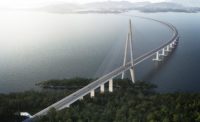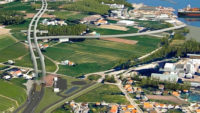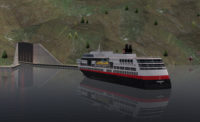A 4-kilometer-long floating bridge, which would break the current world record by 2,754 meters, and the first floating tunnel, also 4 km, are among a series of remarkable highway structures, estimated to cost $24.5 billion, planned along more than 1,000 km of Norway’s E39 coastal highway.
Government engineers studying the fixed crossings of seven fjords, which are too wide and deep for conventional structures, say the project is likely to push the boundaries of bridge design well beyond current limits.
The structures would eliminate seven ferry crossings of fjords along the coast and help reduce a 20-hour drive between Kristiansand and Trondheim by up to 8.5 hours, forecasts Olav Ellevset, project manager for the E39 upgrade study for the Norwegian Public Roads Administration (NPRA), Oslo.
NPRA recently released the $7.3-million study’s interim findings. Ellevset’s aim is for the final report, due later this year, to secure government backing for four more years of detailed studies. The goal is to start construction later this decade.
The study, which began nearly two years ago, has focused mainly on Sognefjord, some 100 km north of Bergen. With a width of 3.7 km at the best crossing point and water some 1,200 m deep, the fjord is by far the most challenging, says Ellevset. However, some work also is being done on two other, more representative fjords that are roughly half as deep as Sognefjord, he adds.
The study team has been working with mainly Norwegian consultants and some international technical support, mostly from Denmark's Cowi A/S, Copenhagen. Norwegian engineers have considerable experience with major highway structures because of Norway's difficult topography, Ellevset adds.
Norway's longest suspension bridge, now nearing completion over the Hardangerfjord southeast of Bergen, will span 1,310 m. The 19-year-old E39's Nordhordland crossing of the Salhusfjorden, just north of Bergen, includes the world's longest unanchored floating bridge, at 1,246 m, according to its lead designer, Aas-Jakobsen AS, Oslo. Some 200 km away, the world's first floating tunnel came close to construction before the planned 1,400-m-long Høgsfjord crossing in Stavanger was shelved in 2000.
The government's “Fjord Free E39” program, if implemented, would dwarf all these schemes. With sufficient backing, the NPRA team thinks plans for a 3.7-km suspended span—400 m longer than Italy's planned, record-breaking Messina Straits crossing—could be ready for procurement in 2016. The floating-bridge scheme could be available for bidding a year later, and a floating tunnel of the same length could follow in 2018.
But even before NPRA's final report is published, the isolated municipality of Rissa, some 40 km northwest of Trondheim, is urging the government to build yet another record-breaking span. To connect the town to the E39, a bridge over Trondheimsfjord must be built. The crossing proposal includes a 5.3-km-long floating, anchored bridge, more than two times longer than the 2.3-km-long pontoon crossing of Lake Washington, near Seattle, which is due to be the world's longest when it opens in 2015.
The Trondheimsfjord crossing, which would include a 1.4-km-long cable-stayed bridge with pylons founded on rock outcrops in the fjord, would cost around $2 billion, estimates Rissa's Copenhagen-based consultant, Ramboll Group. Though ambitious, the bridge would be technically feasible, adds Terje Norddal, Ramboll's senior adviser.











Post a comment to this article
Report Abusive Comment